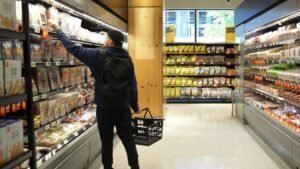Customers may start noticing changes as early as next week, according to company spokeswoman Catherine Thomas.
Following U.S. President Donald Trump’s decision to impose tariffs on Canadian goods last week, the Canadian government responded with its own tariffs on a wide range of American imports.
To help customers identify which products are affected, Loblaw has introduced a new “tariff” symbol—a letter T inside a white triangle on a grey background.
In a LinkedIn post on Monday, CEO Per Bank assured Canadians that prices in stores would not immediately rise due to tariffs.
“As expected, we have inventory of U.S. products in our distribution centers that were purchased before the tariffs took effect. This means that many prices won’t be affected until those stocks are depleted,” he wrote.
“However, tariffs will eventually impact the cost of certain items—some as soon as a week or two, particularly fresh produce.”
For other products, Loblaw anticipates price increases will begin appearing on store shelves in about six weeks, according to the company’s website.
The new symbol is currently being tested across Loblaw’s store network, helping customers identify U.S.-sourced products whose prices are rising due to tariffs.
“Customers can be assured that once tariffs are lifted, any price increases related to them will be fully removed,” Bank stated.
In addition to the tariff symbol, Loblaw is introducing a maple leaf icon for products made in Canada with domestic and/or imported ingredients.

Thomas explained that even some products prepared in Canada could see price increases if they contain ingredients sourced from the U.S. Other factors, such as fluctuating commodity prices and a weaker Canadian dollar, could also contribute to higher costs.
Products labeled “Product of Canada” or “Made in Canada” contain an even higher proportion of domestic ingredients and manufacturing, she added.
Loblaw has previously stated it is working to replace certain U.S.-sourced products with alternatives from Canada or other countries to mitigate the impact of tariffs. Other grocery retailers have made similar moves, introducing initiatives to highlight Canadian products in their stores.
However, Canada remains highly dependent on U.S. imports for certain goods, particularly fresh produce during the winter months, making some substitutions more challenging.








































